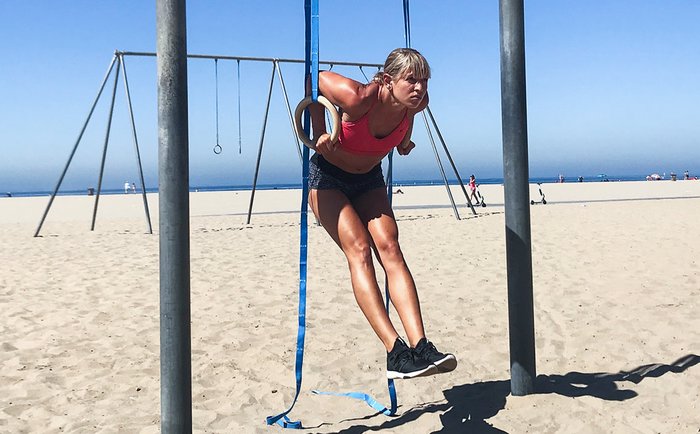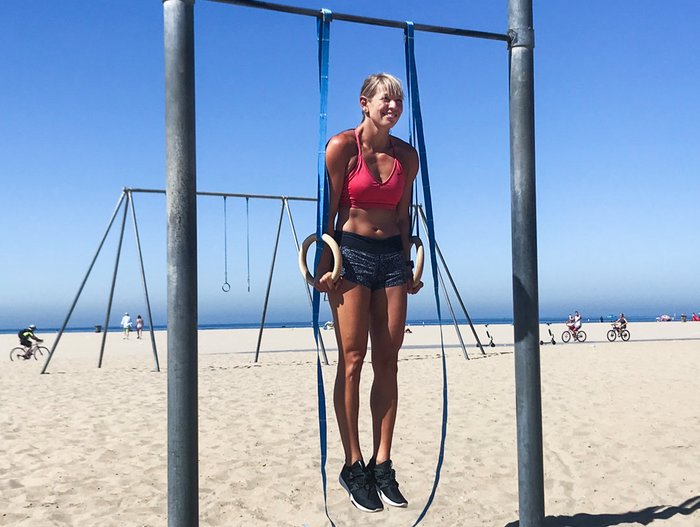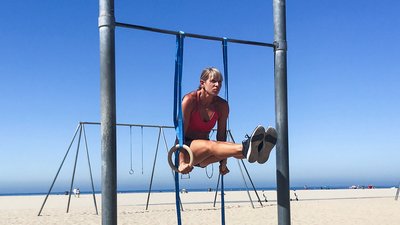If any training apparatus fits the phrase “harder than it looks,” it would be gymnastic rings. What looks effortless on TV during the summer Olympics is insanely difficult. In fact, simply holding your body motionless while using the rings will make you feel muscles you didn’t even know you had until that moment.
Nonetheless, gymnastic rings might be one of the single greatest training tools to develop upper-body and core strength for the beginner and advanced lifter alike, and once you know what you’re doing, you too can achieve proficiency, if not gold-medal status. Here are five reasons why you should start adding gymnastic rings to your training routine in the gym.
Reason 1: The Instability of Gymnastic Rings Leads to Greater Strength Gains
Any time you add instability to an exercise, it forces your muscles to work harder. For example, you might have an easy time doing dips off the bench or parallel bars, only to find you struggle to get the same number of gymnastic reps on the rings. Same goes for the pull-up. The added challenge of stabilizing leads to greater strength gains than you would otherwise get with a stable surface.
Since gymnastic rings can be hung from a ceiling or playground apparatus, they can quickly make even the simplest exercises in your training routine more challenging. All that wobbling around will make your bodyweight exercises that much more difficult—and much more effective in your workout. It may take time to build yourself up to a pull-up, for example.

Reason 2: The Adjustable Width of Gymnastic Rings Allows for Customized Training
Although parallel bars at outdoor fitness parks and gyms are useful pieces of equipment, they're almost always too wide for the average person. If you've ever felt pain in your shoulders or elbows when trying to do exercises on parallel bars, this is most likely why. Just for reference, parallel bars are usually at least 25 percent too wide for most people!
The correct width for dips and other support exercises is no wider than approximately the length from your elbow to fingertips. With gymnastic rings, you can easily adjust the width to fit your own body, making every exercise in your training routine safer and less likely to cause injuries.
Reason 3: The Length of Gymnastic Rings Can Be Easily Adjusted
All gymnastic rings automatically come with adjustable straps, allowing you to adjust the height of the rings to perform a variety of awesome exercises. Shorten the straps for the ring version of the mighty pull-up and muscle-up, drop them down to waist height for L-sits and dips, or go all the way to the floor for push-ups and ab roll-outs.
The adjustability of gymnastic rings also helps if your height makes it difficult to use a standard pull-up bar in the gym. Taller individuals whose feet normally touch the floor can set the rings higher; shorter individuals who can't quite reach the bar can use rings instead.

Reason 4: Gymnastic Rings Are Portable
One of the best things about gymnastic rings, even for someone struggling to do their first chin-up, is they work great in the gym, but they are also 100 percent portable. You can bring them with you on vacation for quick workouts or take them outdoors for your training when the weather is nice. All you need is something sturdy to throw them over like playground bars, a sturdy tree, or even a basketball hoop, and you have an awesome training tool at your disposal, even if you're a beginner.
Reason 5: Gymnastic Rings Help Bulletproof Your Body
Because gymnastic rings significantly help strengthen all your smaller stabilizing muscles around your shoulders and elbow joints, training with them in your routine on a regular basis helps to prevent common joint injuries. In addition to the added strength benefits, this feature helps you create an unstoppable, bulletproof body.
Not quite a chin-up pro yet? Unless you're a gymnast, start slow with ring training. Ease into using them in your gym workout. The muscles and tendons surrounding your joints take time to strengthen, and diving in too quickly may end up straining those muscles and even causing long-term injuries if you're not careful.
If you're a beginner when it comes to using rings, start with basic support holds to help build strength and stability in your shoulders. Hang the rings at a height where you can boost yourself up on top of them. Once in this position, push through your shoulders and tighten your core as you externally rotate your elbows so that your elbow pits face forward. Hold this position for time, working up to three holds of 30 seconds or more.
If you like this style of training, check out Total Fitness with Andy Speer on BodyFit Elite. Over eight weeks, you’ll develop more of the sort of functional fitness that helps you crush challenges like the gymnastic rings!

